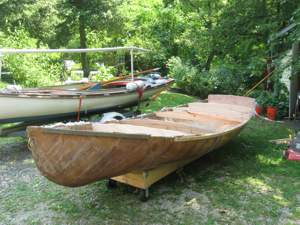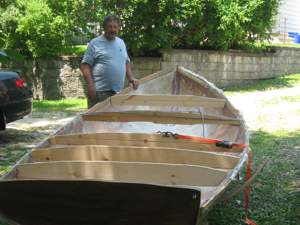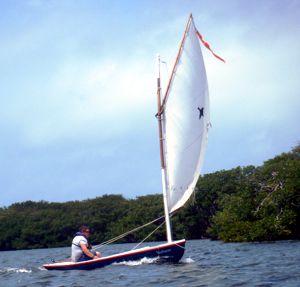|
|
|---|---|
| Continued from the Melonseed Page And they are beautiful, not the saucer shape of a sneakbox. I spend lots of my building time just looking at my new boat from all different angles. That is very important to keep in mind as you spend your time building your boat. It is going to be “Yar”. That makes the building time worthwhile. They are seaworthy with their fine entrance and sleek low hull. They are wider than other early hunting boats and have good form stability. I never have any thought of capsize; But rafted up to a catboat of the same length, the melonseed has only half the freeboard. This means that the sailor must expect to get wet in the afternoon Chesapeake slop where shallow water makes small but frequent waves. Once I am in deeper water, when the swells lengthen, I find the spray problem disappears, and I stay dryer. One trick is to find get a gullible crew to sit forward and keep some of the spray from the skipper. But, it is only spray. There is never danger of swamping. They aren’t ever that wet, and a few minutes of pumping empty the bilge . It is the hunting origins that give melonseeds many of their peculiarities. The after deck is large to carry duck decoys, and it has toerails to tie them to. The boats are low to sneak up on the hunter’s prey. They have a high camber deck so the hunter can lie in the cockpit and conceal himself, and the deck keeps the boat from swamping. The simple, unstayed rig is quick to stow inside. The simitar daggerboard and the barndoor rudder allow for control even in the shallowest water. While sailing in Chincoteague Bay, I was zipping in and out of the shallow bays, Winter’s Quarters and Pope’s Bay on the western edge of Assateague Island, and a canoeist complained to me that I was sailing in places he couldn’t even paddle his canoe. A survey of the other ‘seeds in this site shows that there are many modern techniques that can be applied to building these fine boats, stitch and glue, glued lap, strip plank, cold-molded, and traditional. Cedar or plywood planks make melonseeds a good choice for builders. I wish I had the time and the space to try them all, and keep them all. But my garage is full. |
|
“How come two melonseeds?” Ten years ago, John Guidera and I met and started sailing together. I had a small MacGregor decked Sailing Canoe, and he had a Tomas Firth Jones designed Melonseed. We sailed along the Maryland and Virginia barrier islands, Assateague, Chincoteague, Wreck, Paramore. My canoe was too small for this kind of sailing and camping, so I found a Bolger Gypsy in bad condition. I fixed her up until the point where there was almost nothing left of the original boat, and she became a great camp cruiser. Still is. But, thanks to my sailing with John, I was in love with Melonseeds Down in Cortez, Florida Roger Allen had designed a 16 foot melonseed, a Cortez Melonseed. David Lucas started building them in his open air shop. He and his friends built about nine boats. This was my chance to get a melonseed of my own. I arranged to give a presentation at the monthly meeting of our Delaware River Chapter of the TSCA and see if I could talk our members into building a few boats Carl Weissinger had built a lovely 16 footer named JOLLY CODGER to John Brady’s design, and I asked him to bring along his pictures, because the two designs were almost identical. He said he would, but he also said “She is for sale, Cheap.” That’s how I got my first melonseed. My wife objected to the name, JOLLY CODGER, saying one of the words was false advertising. She wouldn’t say which word. Since melonseeds used to be called pumpkinseeds, I renamed her PEPITA. As soon as spring arrived John and I trailered our melonseeds down to Cortez for the festival there. We had a wonderful time, gunkholing, racing, and partying in Cortez, Sarasota, and Cedar Island. During the race for the famous Mullet Cup, David Lucas beat me by about a boat length; That was my big mistake. David is a fine sailor, how could I make up that boatlength. I considered every “go-fast” Vectran, Robline, Dynema, Titanium, spent uranium ballast, I went down the list but nothing seemed very practical. David solved my problem. He didn’t even ask, he just built a new bare hull and gave it to me. I heard about it from friends. That’s a man who knows he is a good sailor. So, I drove an empty trailer to Florida and picked up my new hull, planted her in my garage and slowly began building my new Cortez Melonseed. I couldn’t beat such a good sailor as Dave with an identical boat, so I used the bare hull as a male mold and cold-molded my new hull around it. As soon as I got my boat, MOGGIE, to the fruit-bowl stage, I popped her off David’s hull and passed that on to Roland Anderson. |
|
 |
 |
Now, I am on the home stretch with rig, hull, deckbeams, rudder, centerboard all finished. I am waiting for some milder weather to finish up. My garage is under a foot of snow right now, but once I dig it out, it’s back to work. Heatlamps, propane heaters, tarpaulin tents help with the temperature. I am excited about building the plywood deck. I put a deck on my Bolger Gypsy out of 4 mm occume, but even with fiberglass on both sides, I get a little oilcanning from that deck, so MOGGIE’s deck will be 5mm. Two sheets of ply are each cut into two pieces to make four corners of the deck. I want the deck to be cloth and epoxy on both sides, so I will make a curved cradle and nestle each section into the cradle. Then I epoxy the cloth on the bottom side and wait until it reaches the green stage, but not too green. At just the right moment I carry it over to the boat and capsize it into place. I quickly fasten each quarter of the deck down onto the deckbeams and the gunwales. “Will it work ?” I hope so. Once my boat is all finished, then the fun begins. My boat will be identical to David’s LAYLAH, but David is a good sailor. “Will I be able to beat him ?”
|
|

